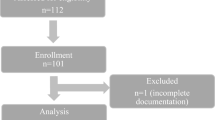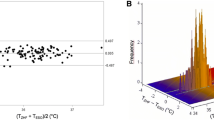Abstract
Objective. This study sought to determine whether continuous gastric suctioning influences esophageal temperature measurements.Methods. This study evaluated 21 patients scheduled for extremity or lower abdominal surgery. After induction of general endotracheal anesthesia, an orogastric tube, and esophageal and nasopharyngeal temperature probes were placed in functional positions. Baseline esophageal (Tes) and nasopharyngeal (Tnas) temperatures were recorded and the orogastric tube was placed on continuous suction. After the first 11 patients (Group I) were studied, 10 additional patients (Group II) were studied with more frequent data collection to improve the time resolution of temperature changes. Temperatures were recorded for patients in Group I at 2 and 10 min with suctioning and 10 min after cessation of suctioning. In Group II, temperatures were recorded at 1, 2, 5 and 10 min with suctioning and 10 min after cessation of suctioning. Analysis of data was performed using repeated measures analysis of variance and pairedt-tests with the Bonferroni correction.Results. In Group I, Tes decreased significantly from 35.9 ± 0.2 °C (mean ± SE) to 35.1 ± 0.4 °C at 2 min and 34.8 ± 0.3 °C at 10 min of suctioning (p < 0.01). Ten minutes after cessation of suctioning, Tes was not significantly different from the baseline measurement. Tnas did not change significantly over the 20 min observation period. In Group II, Tes continually decreased from 36.2 ± 0.1 °C to 34.8 ± 0.3 °C after 10 min of suctioning (p < 0.006) and returned to near baseline 10 min after cessation of suctioning. There was no significant change in Tnas over the 20 min observation period.Conclusion. We conclude that continuous gastric suctioning decreases esophageal temperature measurements. This phenomenon should be recognized as an artifactual change in esophageal temperature and not a reflection of core temperature.
Similar content being viewed by others
References
Frank SM. Body temperature monitoring. Anesthesiol Clin N Am 1994; 12: 387–407
Cork RC, Vaughan KW, Humphrey LS. Precision and accuracy of intraoperative temperature monitoring. Anesth Analg 1983; 62: 211–214
Sessler DI. Consequences and treatment of perioperative hypothermia. Anesthesiol Clin N Am 1994; 12: 425–456
Crino MH, Nagel EL. Thermal burns caused by warming blankets in the operating room. Anesthesiology 1968; 29: 149–150
Kaufman RD. Relationship between esophageal temperature gradient and heart and lung sounds heard by esophageal stethoscope. Anesth Analg 1987; 66: 1046–1048
Whitby JD, Dunkin LJ. Temperature differences in the oesophagus. The effects of intubation and ventilation. Br J Anaesth 1969; 41: 615–618
Weglinski MR, Wedel DJ. Differential diagnosis of hyperthermia during anesthesia and clinical import. Anesthesiol Clin N Am 1994; 12: 475–489
Author information
Authors and Affiliations
Rights and permissions
About this article
Cite this article
Nelson, E.J., Grissom, T.E. Continuous gastric suctioning decreases measured esophageal temperature during general anesthesia. J Clin Monitor Comput 12, 429–432 (1996). https://doi.org/10.1007/BF02199703
Received:
Accepted:
Issue Date:
DOI: https://doi.org/10.1007/BF02199703




